Kate Betts has been remarkably successful: She was Fairchild's Paris bureau chief by 27, Anna Wintour's protege at Vogue, and then editor of Harper's Bazaar at 35—the youngest editor ever to take over a fashion magazine. But she's also faced remarkably intense scrutiny, even for the catty world of fashion glossies. She was called a traitor when she left Vogue, and at Bazaar she had to fill the shoes of beloved editor Liz Tilberis, who'd died months earlier. Her redesign was widely criticized, newsstand sales slipped (they'd been declining even before Betts took over), and she was fired in 2001.
But if there's anything the magazine industry likes better than a spectacular failure, it's a spectacular comeback, and Betts is ready to make hers. After a year and a half spent freelancing for the New York Times "Style" section, she just bowed her first issue of Time magazine's new, biannual Style & Design supplement (one previous issue was published in February). She spoke to mediabistro.com last week about starting from the bottom, surviving the spotlight, and coming out on top.
Birthdate: March 8, 1964
Hometown: New York City
First section of the Sunday Times: "I'm embarrassed to admit it's the real-estate section."
You've taken over an established magazine and now you're essentially rolling out a startup. How are the pressures different?
The pressure of Bazaar was, obviously, that venue existed for so long, in such a high-profile way, under Liz Tilberis before I got there, and this magazine didn't really have that high of a profile or that strong of a footing in this market. They'd only done one issue in the U.S. before I did this one. And the pressure was to create something that was going to be interesting to the Time reader and also to the fashion industry, two very different audiences.
I wanted to give the Time reader an inside look at fashion but not make it too obscure and too over-the-top or detailed in a way that wouldn't reach them. And, to be honest, that's always been my interest in fashion—I've always been interested in more of a journalistic approach, even when I was at Vogue. When I started writing for the "Style" section, I was pleasantly surprised by the number of people who actually read the section. So it turned me on to writing for a much larger audience than I was used to. The excitement and pressure of this job is to speak to millions and millions of readers, as opposed to people who were just looking for fashion information.
You say you want Style & Design to appeal to the Time reader and also the fashion industry. What about the readers of fashion magazines?
Well that, to me, is the fashion industry, or an extension of it. When I say "the fashion industry," I mean the industry but also people who are looking for fashion information and who already have a lot of fashion education.
What was it like going from writing for the Times as a freelancer to starting something practically from scratch?
I had been working at Time Inc. full-time since January, so I wasn't like, getting out of my pajamas for the first time in two years. Almost! But I had to put together a little team. I brought the art director, Terry Koppel, with me, and I brought Andrea Ferronato, who I'd worked with at Vogue, as the photo editor. So we had that capsule team, and we had some great people here at Time who were assigned to help us move the issue through the system, because the system here is really gigantic and different. The most exciting thing for me, as a writer, was being able to use some of the writers at Time who I love, like Richard Lacayo and Michele Orecklin and Joel Stein, and to draw on the global bureaus. No other magazine that I've worked for has that kind of resource.
Are there other ways that the culture at Time is different from those at Vogue and Bazaar?
There is a great camaraderie here that I've never experienced. At fashion magazines, there's a very distinct kind of ambience. Everyone who works here is, first of all, incredibly smart, which was sort of a shock. And, second of all, they're all really helpful, and you do get the feeling that everyone's working together toward the same goal—it's not like this sort of backbiting thing. It creates a really nice can-do spirit, and Time staffers have worked together on much bigger and more important projects, and pulled together as a team in ways that are incredibly impressive.
Do you have a lot of give and take with the editors of Time, or does Style & Design have its own team?
There is a lot of give and take. All the editors here have been extremely helpful. The thing about the writers here is that they're pulled onto all different stories at any time of day, so it's hard to get their time. But the people that did end up writing for the issue were incredibly quick and professional about it.
Style & Design comes out twice a year. Will it occupy you full time, or will you be doing other work?
I've also been writing for the weekly edition of Time. At first I just did little trend things in the "Personal Time" section, and this week I have a story about Sofia Coppola in the "Arts & Movies" section, and I'm working on a few other things. We're thinking about doing more frequency for Time Style & Design—we're meeting on that right now.
One thing I found interesting about Style & Design was its meta approach: You're covering the fashion magazines in a way you would never see elsewhere—you'd never read in Vogue about the photographer who shoots covers for Bazaar.
Yeah, it's an interesting place. That is something we discovered as we were going along. I've always worked at either Vogue or Bazaar, so I didn't really think about being in the middle or above those two. So it suddenly dawned on us that we were in the position to cover everyone.
Had you maintained a lot of your connections at those magazines, or did you have to go back and rebuild bridges?
I'd been in touch with a lot of the people I worked with at Bazaar, and some of them contributed to this issue. Mostly I just had to get back into the business. I was out of it for a year and a half, and I hadn't gone to that many shows. I went to the menswear shows for the first time in Milan in June, and I went to the couture shows.
You know, it doesn't change that much, the fashion business. It's a business predicated on change, but the people in the business don't really change. So everybody was pretty much in the same place as when I left. And I'd kept in touch with a few people just from writing for the "Style" section. It's weird—I've always felt like an outsider inside the business, and so I've always taken that approach to covering it.
From your bio, it seems like you never had to slave away at an entry-level job.
No, no, no, no, no—let me just disqualify that right away. First of all, when I started at Fairchild in Paris, I was a reporter. I was reporting on the lingerie business and perfume launches—what everybody at Women's Wear Daily has to start off with. That's where you learn about the industry; that's the baptism by fire. You learn about fabrics, you have to cover Premiere Vision, which is the big fabric fair in Paris, and you have to figure out who the perfume nose is at Christian Dior and the difference between the fragrances. You have to learn a lot about the people and processes of each industry within the fashion industry. And that's the best way to learn about fashion.
When I went to Vogue after three years at Women's Wear, I couldn't believe that the market editors didn't know about fabrics. I mean, of course the big editors, Andre Leon Talley or Polly Mellen, they all knew about fashion, but these junior editors, they had no way of learning the way that Women's Wear editors learn: from going to fabric fairs and actually having to know what they're talking about. So that was a great way to learn, and it's definitely starting at the bottom. If they decide they want to cover something at the last minute in Dusseldorf, you have to get on the plane and go to Dusseldorf. It sounds glamorous, but it's this gigantic trade show and everyone speaks German, and there you are: Find a story. But it was really fun too.
And then when I got to Vogue, when I started off, my office was literally a closet. Nobody would talk to me, and I remember sitting in there and crying for the first three months. It was pathetic. But the people there were these giant personalities. Especially at that time, because it was 1991—Carly Cerf de Dudzelle, and Andre, and Candy Pratts Price—it was like the '80s were still going on. And I was writing captions for fashion portfolios and "Vogue's Point of View," that page of writing before the well. So these were not glamorous jobs. But I was lucky because Anna was a great boss in the way that she let me do whatever I wanted. There was always room to create and write and do new things.
You've had amazing success and also endured a tremendous amount of criticism and setbacks. How do you bounce back?
I don't look at it as an amazing career, funnily enough. I look at it like, I've always worked really, really hard. I remember one summer at Vogue, I worked every weekend the whole summer. Covering the collections is a lot of work. I mean yeah, it's really glamorous and you meet Tom Ford and blah blah blah, but you're running around like crazy and reporting and it's a lot of work.
But you've been watched so closely, both as Anna's protege and then taking over Bazaar after Liz Tilberis. What advice would you give others facing adversity in their careers?
Well, it's hard. The Bazaar situation was a very particular confluence of events—following in the footsteps of Liz Tilberis, taking over a magazine that was not doing so well, having a baby three days later, having a large turnover on the staff, and dealing with all that in the spotlight is a lot at once. It was one of those things where it was a job you can't say no to, even though I was nine months pregnant. I think the most important thing in careers, and I think this a lot in my own career now, is you have to do what you want to do. I felt for a long time a tremendous pressure to do things other people wanted me to do, and when you're young, that is probably the case. But you really do have to go with your heart. It's weird, all the criticism and all the tough calls at Bazaar, and getting fired ultimately, those were all hard things to experience, but with hindsight, which is always 20/20, they were great experiences. I don't regret any of it at all. It was an amazing opportunity to learn how to edit a magazine in two years, and get it over with. There are a lot of lessons there, but the thing I always come back to is, if you're doing something you really believe in, you never regret anything you do.






 ).
).


























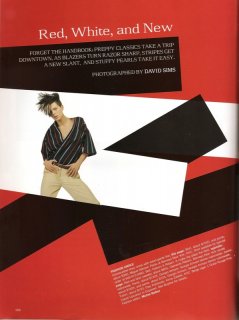
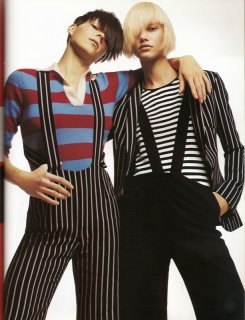
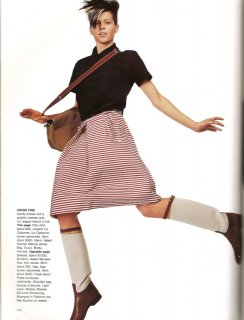
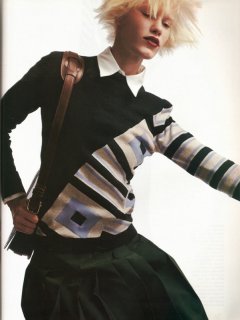

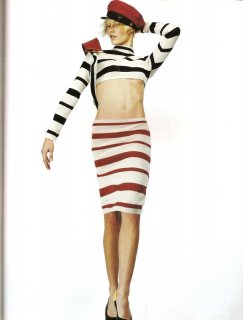
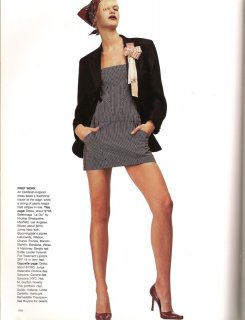
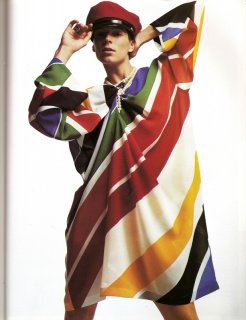

















 [URL=http://img823.imageshack.us/i/nyyj.jpg/]
[URL=http://img823.imageshack.us/i/nyyj.jpg/]





 [URL=http://img183.imageshack.us/i/beret.jpg/]
[URL=http://img183.imageshack.us/i/beret.jpg/]











